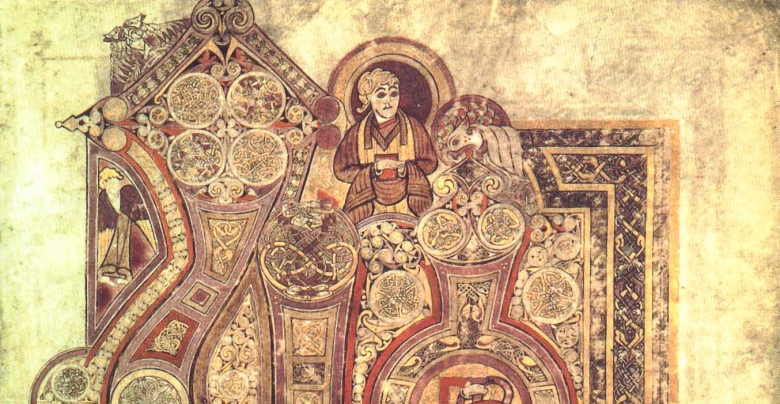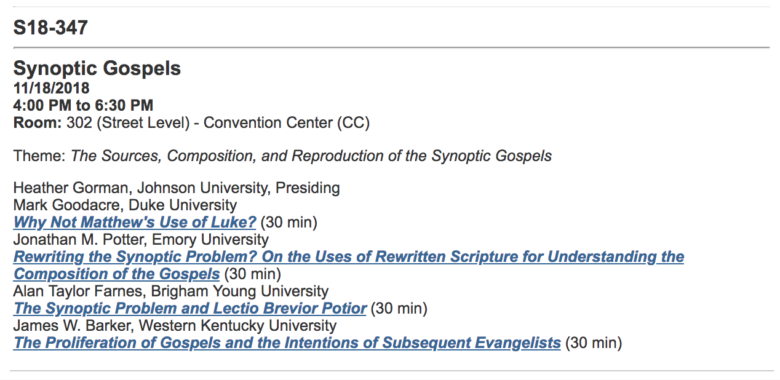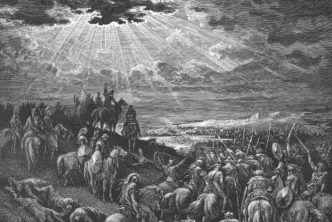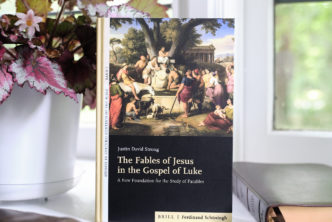
In anticipation of Mark Goodacre’s paper at SBL on 18 November (see information below), Alan Garrow has kindly contributed the following article on Ron Huggins, the scholar who coined the term “Matthean Posteriority.”
Ron Huggins taught at Moody Bible Institute—Spokane, Salt Lake Theological Seminary, and Midwestern Baptist Theological Seminary. He is a former Editor of The Midwestern Journal of Theology.
His “Matthean Posteriority: A Preliminary Proposal.” Novum Testamentum 34 (1992): 1-22, has had a pivotal role in birthing the current resurgence of interest in the case for Matthew’s use of Luke. Here is the story behind that article:
 My article “Matthean Posteriority: A Preliminary Proposal” (1992), originated as a paper written for the Q Seminar of the late Professor Heinz O. Guenther, which I took during the first semester of my doctoral studies at the University of Toronto/Toronto School of Theology. My argument was that Q might be dispensed with if we assume that Luke used Mark and that Matthew used both Luke and Mark. The form in which the article appeared in the journal is identical to the copy I turned in to Professor Guenther, indeed I submitted both, albeit quite late with regard to the seminar, on the same day, one to Professor Guenther and the other to the post office addressed to the journal.
My article “Matthean Posteriority: A Preliminary Proposal” (1992), originated as a paper written for the Q Seminar of the late Professor Heinz O. Guenther, which I took during the first semester of my doctoral studies at the University of Toronto/Toronto School of Theology. My argument was that Q might be dispensed with if we assume that Luke used Mark and that Matthew used both Luke and Mark. The form in which the article appeared in the journal is identical to the copy I turned in to Professor Guenther, indeed I submitted both, albeit quite late with regard to the seminar, on the same day, one to Professor Guenther and the other to the post office addressed to the journal.
Guenther, always extremely fastidious when it came to the interests and scholarly development of his students, returned the paper with several pages of comments made in red ink, concluding that it was “beyond the pale” for the course, but nevertheless, to my great relief, assigning it an A. Not long afterwards, I remember Professor Guenther taking me aside, and, in a fatherly sort of way, urging me that “life was too short,” to strike off on my own looking for a new solution to the Synoptic Problem. Better, he said, to join one of the established schools and engage in meaningful research along with others there.
In those days the University of Toronto was particularly strong in Synoptic Studies, as I suppose it still probably is. This is seen in the fact that prominent Q scholar John Kloppenborg came a little before me in the program and Bob Derrenbacker a little after. As a result, I became cognizant very early of both the elegance and tremendous explanatory power of the dominant two-source theory, a thing I still fully appreciate. I did wonder, however, whether part of the reason it seemed so persuasive to me was that I wasn’t hearing the other side of the arguments. This led me to feel I needed to explore the potential viability of the alternative solutions as well, including of course the one presented in Austin Farrer’s 1955 article “On Dispensing with Q.” Farrer attempted to dispense with Q by proposing that Matthew used Mark and Luke used Matthew and Mark. His most energetic disciple today is Duke University’s Mark Goodacre.
At first Farrer’s hypothesis seemed promising, much more so than other alternative solutions I’d looked at, because unlike them, it affirmed Marcan Priority (the idea that Matthew and Luke used Mark, not the other way around), which by that time seemed to me to be an inescapable fact.
In any case, I set to work trying to make sense of what I saw going on in the Synoptic Gospels (and had been made to see by Heinz Guenther and then afterward by Joseph Plevnik S.J.) through the grid of Farrer’s solution. I understood that since Synoptic Studies had gained a great deal of precision since Farrer’s article, I might even need to refine the theory a bit myself in order to make it work. I very quickly found myself liking Farrer’s view and actually hoping he was right. And yet as I put it to the test point by point, passage by passage, I kept finding myself again and again running up against places where it just didn’t commend itself as a solution, places where Matthew seemed more developed than Luke.
This was, of course, what I had in a way expected, since I was already aware of the claim by defenders of the two-source theory, that both in order and in form, Luke is generally “more primitive” than Matthew in the double tradition (i.e., in Q). This is why for example Q passages usually take their chapter and verse references from Luke rather than Matthew. According to The Critical Edition of Q there are only eleven places where Matthew rather than Luke is thought to preserve the original order of Q. So, I faced the question rather early whether Matthew was really ever indisputably “more primitive” than Luke when it came to their shared Q material. And I was surprised to find that even as I looked at those eleven passages, which included, for example, Jesus’s temptation in the wilderness, and his teaching about houses built on rock and sand, it was by no means obvious to me that Matthew really could be shown to be “more primitive” than Luke.
For two-source theorists the idea that sometimes Matthew and sometimes Luke preserves Q in its more original form and/or order, a phenomenon they call “alternating primitivity,” is a key argument given for why Luke and Matthew had to get their shared non-Maran material from Q rather than from one another. Yet looking at those few places where Matthew was deemed “more primitive,” it was not long before I began to suspect that the two-source defenders found their few examples of Matthew’s being “more primitive,” because their theory led them to expect to find them. In other words, alternating primitivity was being discovered, only because it was already presumed to exist. I could not see that it was a position they were in any way pressed into embracing by the evidence itself. This is why I put the matter as definitively as I did in the article: “The solution offered here will ultimately stand or fall on whether it can be demonstrated beyond doubt that Matthew is more primitive than Luke at certain points in the double tradition.”
In any case, the very fact that I was finding myself agreeing that Matthew was anyway most often less primitive than Luke in material designated Q represented a significant blow to Farrer’s thesis. If Luke really was using Matthew, why and how was he making the material consistently look “more primitive”?
As I looked more closely at particular passages, the inadequacy of the Farrer position became even more obvious. The reason was that it in order for Farrer to be right it would require Luke taking nicely ordered things from Matthew, picking them apart, and scattering them around in different places in his Gospel for no apparent reason. A case in point is the famous woes passage of Matthew 23. In Matthew we find the woes all neatly presented one after another in a row, each one starting with an identical stereotyped introduction: “Woe to you Scribes, Pharisees, hypocrites” (23:13,14,15,23,25,27,29). So, if we want to say Luke is getting his woes from this passage in Matthew a number of whys emerge to trouble us. First, why did Luke drop two of the woes (23:15 and 25)? What was his driving “redactional” (editorial) principle for doing so? Why did he break up the passage itself, putting three woes (in different order) in his 11th chapter, and one in his 20th chapter? But most significantly, why did he get rid of Matthew’s neatly repetitive introductory formula, “Woe to you Scribes, Pharisees, hypocrites,” and replace them with a range of different introductions: “Woe to you Pharisees!” (11:42 & 43), “Woe to you…” (11:44- 47), “Woe to you lawyers also!” (11:46), “Woe to you lawyers!” (11:52), “Beware of the Scribes” (20:46)?
Now I could see of course that with a little ingenuity I could invent what might pass for a reason why Luke had done these things. I could say, for example, that he was interested in being more precise in attributing certain woes to certain groups. But I already knew that the problem was larger than this. This was only one instance where if Matthew came last his editorial activity he would be showing evidence of a propensity for greater organization, whereas if Luke came last, his could only be described as being driven by a tendency toward greater disorgnization. And yet why should that be the case since where we can also check him against Mark we find that he treated his material there quite differently, quite conservatively.
Two places where this really came home to me in passages shared by Matthew and Luke, were (1) the Salt of the earth/Light of the world sayings, and (2) the Sign of Jonah saying.
Salt of the Earth / Light of the World:
|
Matt 5:13-15: You are the salt of the earth; but if salt has lost its taste, how can its saltiness be restored? It is no longer good for anything, but is thrown out and trampled under foot.
You are the light of the world. A city built on a hill cannot be hid. No one after lighting a lamp puts it under the bushel basket, but on the lampstand, and it gives light to all in the house.
|
Luke 14:34-35: Salt is good; but if salt has lost its taste, how can its saltiness be restored? It is fit neither for the soil nor for the manure pile; they throw it away. Let anyone with ears to hear listen!”
Luke 8:16-17: No one after lighting a lamp hides it under a jar, or puts it under a bed, but puts it on a lampstand, so that those who enter may see the light. For nothing is hidden that will not be disclosed, nor is anything secret that will not become known and come to light.
|
In this first case we also have a Mark/Q overlap which I didn’t show (see Mark 9:49-50). And Luke does agree with Mark’s version to some extent. Yet there is enough overlap between Matthew and Luke where they are not following Mark to be able to tell they have shared additional material. So, if Luke is following Matthew then it represents, in this case, one piece in his larger project of demolishing and redistributing Matthew’s Sermon on the Mount. First of all, Luke would be breaking the passage in two, putting one part in chapter 14 and the other in chapter 8. And at the same time jettisoning Matthew’s nicely balanced doublet “You are the Salt of the Earth…You are the light of the world.” But why would he do that? Again, I felt sure that with a little ingenuity I could come up with a reason, yet I knew in my heart of hearts that a better explanation would probably be that Matthew added the nice couplet to his material rather than that Luke took it out.
The Sign of Jonah (Matthew 11:39-40/Luke 11:29)
This was actually for me the straw that broke the camel’s back with regard to my finally rejecting the Farrer hypothesis. In Matthew 12:39 and 40, Jesus says:
“No sign will be given…except the sign of the prophet Jonah. For just as Jonah was three days and three nights in the belly of the sea monster, so for three days and three nights the Son of Man will be in the heart of the earth.
But in Luke 11:29 we read only:
“No sign will be given to it except the sign of Jonah.”
As I began reflecting on this passage, whatever vestiges of confidence I had in the possibility that Farrer might be salvaged evaporated. The question was whether I thought that if Luke really had the text of Matthew lying there before him, and actually saw and read in Matthew’s text this very striking prophesy of the death, burial, and resurrection of Jesus, from the mouth of Jesus himself, would he really have been likely to remove it as he transferred the passage over into his own Gospel? And for me at least the answer had to be no. No, he would not have removed it. What? Sensor a word from the Lord like this? Surely, he would have kept it, wouldn’t he? Surely. And so, with that, I simply surrendered. Farrer’s solution wouldn’t work. The truth be told he had the whole thing ass backwards. And what I was seeing wasn’t Luke crudely pulling things apart but Matthew elegantly pulling them together.
All this meant for me at the time was that the dominant two-source theory—Mark and Q as sources for the independent Matthew and Luke—was probably the most viable one after all. And yet the time I’d spent working through the material from the perspective of the Farrer hypothesis, forced to ask myself again and again whether Luke or Matthew looked “more primitive,” had had its impact. In rejecting Farrer’s view passage by passage, I was tacitly affirming to myself that if there was interdependence going on it would have made much more sense to think that Matthew was getting his material from Luke rather than that Luke getting his from Matthew.
And yet at it hadn’t yet occurred to me to ask myself whether Q might actually be set aside by arguing that Matthew used Luke. That would only happened a bit later when I was once more engaged in reading defenses of the two-source theory, especially were they were making their arguments about how Matthew and Luke not knowing one another. First of all, of course, they would appeal to alternating primitivity as a proof, which I had already discounted in my own mind, but then they would often move on to present arguments, standard since Streeter, as to why Luke couldn’t have used Matthew. Arguments I now regarded as fully valid. But then they would just jump from there to their conclusion by asserting Luke could not have used Matthew, nor Matthew, Luke. It was there that I saw it. Nobody was actually looking at the evidence the other way around, i.e., thinking through how the evidence would look if one supposed not that Luke used Matthew, but that Matthew used Luke. Instead they all seemed to be tacitly taking for granted that if they’d proved that Luke could not have used Matthew, it followed as well that Matthew could not have used Luke. So I decided one day to sit down to try and see how things would look from that perspective, really expecting to arrive at a dead end rather quickly. To my surprise however that didn’t happen, indeed I found the approach illuminating and more satisfying than I had expected. At the time I had no idea that anyone had attempted this before. I was aware of H. P. West’s similar thesis, but felt that he had framed it in such a way as to sidestep certain issues that I did not feel I could credibly avoid. I only heard quite a bit later from Stephen Carlson that Christian Gottlob Wilke had already argued for my view back in the 1830s.
The article to which Ron Huggins refers is available in two locations:
“Matthean Posteriority: A Preliminary Proposal.” Novum Testamentum 34 (1992): 1‐22. Reprinted in The Synoptic Problem and Q: Selected Studies from Novum Testamentum, ed. David E. Orton. Brill’s Readers in Biblical Studies, vol. 4, 204‐25. Leiden: Brill, 1999.
Mark Goodacre will present on “Why Not Matthew’s Use of Luke” on November 18, 2018 in Denver at SBL:





This idea of “Q” seems to be an example of “Source Criticism” run amuck. My view is that Matthew, aka, Levi, son of Alphaeus, the Tax Collector would have kept notes of what Jesus said and did ; while Luke would have sought out “eyewitnesses,” αυτοπτης. Both are the results of eyewitness accounts, but the sources behind the material of each is much different. It is evident from the Birth Narratives that Luke has the more fuller account (Mary’s recollections) than Matthew’s. But that would be evident since Matthew has arranged his gospel for a different purpose than say that of Luke’s gospel. Even here, it is evident, there is much academic speculation, i.e. educated guesswork, since it really depends how much we accept the conclusions of Papias.
Amen Bryant !!